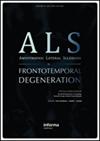主题6组织生物标志物
IF 2.8
4区 医学
Q2 CLINICAL NEUROLOGY
Amyotrophic Lateral Sclerosis and Frontotemporal Degeneration
Pub Date : 2019-10-31
DOI:10.1080/21678421.2019.1646994
引用次数: 0
摘要
背景:谷氨酸兴奋性毒性是ALS病理生理学中一个长期存在的假说。先前的研究表明,ALS患者的血浆谷氨酸水平升高,这表明谷氨酸代谢存在系统性缺陷(1)。我们饮食中消耗的最丰富的氨基酸是谷氨酸。对健康人类受试者的研究表明,通过肝脏、肠腔和肠道细菌中存在的酶的代谢,膳食谷氨酸的有效代谢。越来越多的证据表明,肠道微生物群具有显著的中枢神经系统影响,并且在ALS转基因SOD1G93A小鼠模型中发现了肠道微生态失调(2)。如果肠道微生态失调改变了谷氨酰胺合成酶(GS)产生细菌的流行率,那么饮食中的谷氨酸稳态可能会受损,导致血浆谷氨酸水平升高。目的:本研究检测了来自一个ALS中心的ALS患者和家庭成员队列中,随着蛋白质奶昔的摄入,血浆谷氨酸水平的波动程度。方法:26名患者(占ALS中心随访的总队列的87%)在治疗前和治疗前接受了血浆氨基酸分析的测量 消耗75 gm蛋白奶昔。16名患者的子集继续接受具有高GS活性的益生菌,并在研究期间完成了一系列蛋白质挑战和氨基酸分析。10名未受影响的ALS患者家庭成员接受了类似的蛋白质挑战。谷氨酸代谢障碍(GMD)被定义为餐后与禁食相比差异>30μmol,分为轻度(>30-60)、中度(>60-90)或重度(>90)。ALS患者的GMD严重程度为41%轻度,29%中度,29%重度,仅在家庭成员中发现轻度。在六个月的治疗阶段,75%(6/8)的GMD状态稳定或改善的患者的ALSFRS-R下降率有显著改善,而71.4%(5/7)GMD状态恶化或仍然严重的患者的进展率恶化。讨论和结论:尽管受样本量小的限制,但这项研究确实代表了一个单一ALS中心内的一个极好的样本,也是首次调查ALS患者是否存在饮食谷氨酸代谢障碍的同类研究。如果在更大的ALS人群中得到验证,谷氨酸代谢功能障碍(GMD)的检测可能代表一种与ALS患者潜在治疗靶点相关的新生物标志物。有计划的微生物组分析也将有助于验证这一假设。本文章由计算机程序翻译,如有差异,请以英文原文为准。
Theme 6 Tissue biomarkers
Background: Glutamate excitotoxicity is a longstanding hypothesis in the pathophysiology of ALS. Prior studies have demonstrated increased plasma glutamate levels in ALS patients, which suggest a systemic defect in glutamate metabolism (1). The most abundant amino acid consumed in our diet is glutamate. Studies in healthy human subjects have demonstrated efficient metabolism of dietary glutamate via metabolism by enzymes present in the liver, gut lumen and residential gut bacteria. There is increasing evidence that the gut microbiota has significant CNS effects and intestinal dysbiosis has been found in the ALS transgenic SOD1G93A mouse model (2). If intestinal dysbiosis altered the prevalence of glutamine synthetase (GS) producing bacteria, dietary glutamate homeostasis could be impaired, leading to elevated plasma glutamate levels.Objectives: This study examined the degree of fluctuation in plasma glutamate levels seen with consumption of a protein shake in a cohort of ALS patients and family members from a single ALS center.Methods: Twenty six patients (87% of total cohort followed in the ALS center) underwent measurement of plasma amino acid analysis prior to and 1 hour following consumption of a 75 gm protein shake. A subset of 16 patients went on to receive a probiotic with high GS activity and completed serial protein challenges and amino acid analysis during the study. Ten unaffected family members of ALS patients underwent a similar protein challenge. Glutamate Metabolism Dysfunction (GMD) was defined as >30 umol difference post-prandially compared to fasting, and graded as mild (>30-60), moderate (>60-90) or severe (>90).Results: At baseline, 65.4% (17/26) ALS patients screened were GMD positive, compared to 30% (3/10) of tested family members. The severity of GMD in ALS patients was 41% mild, 29% moderate, 29% severe with only mild severity identified in family members. In the six month treatment phase, 75% (6/8) of patients with stable or improving GMD status saw significant improvements in their ALSFRS-R rate of decline, while 71.4% (5/7) with worsening or remaining severe GMD status experienced worsening of their rate of progression.Discussion and conclusions: Although limited by small sample size, this study does represent an excellent sampling within a single ALS center and is the first of its kind to investigate whether impairment in dietary glutamate metabolism exists in ALS patients. If validated in a larger ALS population, detection of glutamate metabolism dysfunction (GMD) could represent a novel biomarker linked to a potential therapeutic target in ALS patients. Planned microbiome analysis will also help in validating this hypothesis.
求助全文
通过发布文献求助,成功后即可免费获取论文全文。
去求助
来源期刊

Amyotrophic Lateral Sclerosis and Frontotemporal Degeneration
CLINICAL NEUROLOGY-
CiteScore
5.40
自引率
10.70%
发文量
64
期刊介绍:
Amyotrophic Lateral Sclerosis and Frontotemporal Degeneration is an exciting new initiative. It represents a timely expansion of the journal Amyotrophic Lateral Sclerosis in response to the clinical, imaging pathological and genetic overlap between ALS and frontotemporal dementia. The expanded journal provides outstanding coverage of research in a wide range of issues related to motor neuron diseases, especially ALS (Lou Gehrig’s disease) and cognitive decline associated with frontotemporal degeneration. The journal also covers related disorders of the neuroaxis when relevant to these core conditions.
 求助内容:
求助内容: 应助结果提醒方式:
应助结果提醒方式:


